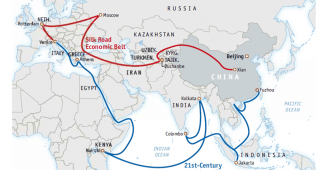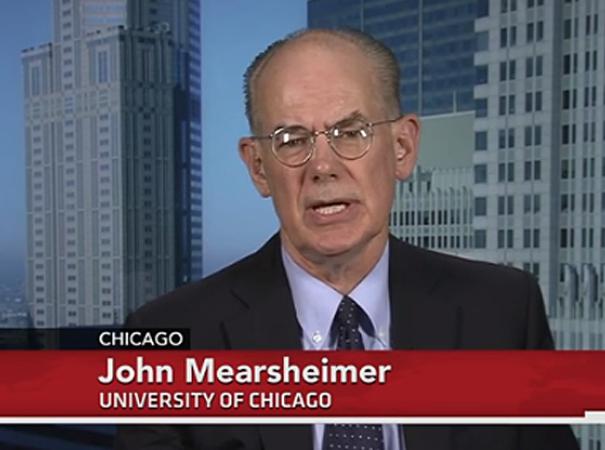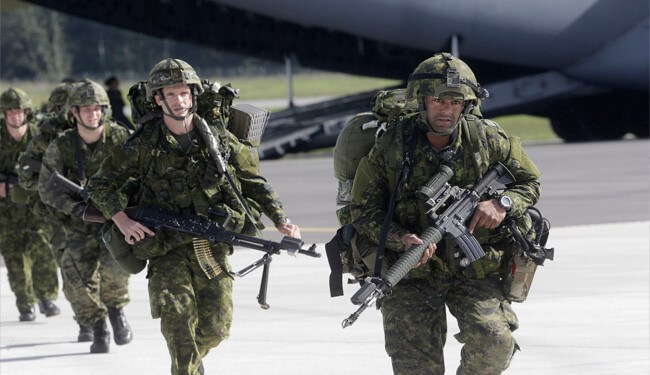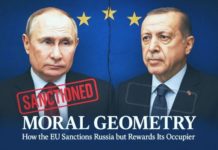By Leonid Savin
Eurasianist ideology has undergone a series of changes over the last 20 years. After Nursultan Nazarbayev, based on a Eurasianist approach, proposed forming a new union in the place of the USSR founded on a new principle, a few years passed before these ideas began to be implemented in state practice. If major milestones associated with intergovernmental projects are considered, then January 1, 2010 can be noted as the date when the Customs Union of Russia, Belarus, and Kazakhstan began to function along with January 1, 2015 when the Eurasian Economic Union (EEU) officially began to function. However, in addition to problems of unifying legal frameworks and defending the interests of the citizens of each country entering the EEU, there exists a trajectory of political philosophy which, although it remains outside of official political activities, nonetheless influences decision-making and the progress of scholarly and public debates in one way or another.
For the most part we are dealing with conceptions of Eurasianism developed by Russian emigrants in the 1920’s, the theory of which later began to be implemented in political practice by a number of scholars and politicians in Russia and Kazakhstan. As is characteristic for the pragmatism of Realpolitik and changes to the international situation, the exact ideas which are outlined in the works of eminent thinkers are not always realized.
The issues of new challenges and threats, from obvious geopolitical confrontation to shadowy and disruptive technologies, many of which are being indirectly or indirectly aimed against the Eurasian Union project, have become particularly relevant.
In this article we will try to delineate some of the possible future trajectories of the future development of the Eurasian Union project while focusing on a number of aspects necessary as a minimum for the functioning of a large state or intergovernmental association. These include questions ranging from political theory and economics to rethinking the world order and defensive strategy.
Etymology as a political construct
First and foremost, it is necessary to define a terminological apparatus associated with the prospects of creating the Eurasian Union. It is impossible to miss the opportunity to expand the already existing terminological base by bringing distinctive innovations to political discourse which reflect deep structures of understanding. As Martin Heidegger said, language is the house of being. In formulating (and reproducing) a corresponding etymology, we participate in the process of not only creating new thoughts, but also new processes related to reorganizing the Eurasian region. In addition, it is necessary to overcome the positivist approach in which Latin and, consequently, Western-centric terminology imposes itself upon the subject. Moreover, it is necessary to work out a lexicon, mechanism, and culture of international relations which are appropriate to the third millennium not only for the region under consideration, but for other corners of the planet.[1]
The name “union” in Russian means bond, or a connection, in referring to a certain community. This is essentially a loan word from the Latin conjūnctiō (connection, contingency, agreement) or the Greek word Σύνδεσμος (connection, link). In considering the paths of development of these terms, we see a significant difference. The widespread English term “union” comes from the same Latin term, but only in truncated form, as the word junction has less meaning and does not reflect the idea of community. Moreover, in a political lexicon this can mean an unstable association, including certain contracts or “unions.” There are more negative interpretations of this concept, such as “junta,” which refer to the numerous coups in Latin American countries carried out by militaries. The accepted interpretation is nominally suitable for a future union, but there are also plenty of other synonyms. However, this will be only a label for forms of intergovernmental structures. What will its content be?
The question of forms of governance (or co-governance) and mechanisms for decision-making immediately arises. Will a Eurasian parliament be created or will legislative power be delegated to an inter-parliamentary assembly of the Eurasian Union? Is the form of delegation of authority according to the European parliamentary example adequate in this situation or is there the possibility of creating a structure more flexible and responsive to the interests of the peoples of the Eurasian Union? Will polycentric law or consociationalism be accepted as tools for resolving socio-political and economic issues? Will economics remain the driving force of the Eurasian locomotive or will there be deeper reasons (albeit difficult for politicians to describe in words) for geopolitical consolidation (as Aristotle said – the whole is greater than the sum of its parts)?
At the current moment, the Eurasian Economic Union practically functions in the format of the Customs Union. New elements, especially the defense factor, personnel capacity, as well as a unifying ideology, have not entered the interests of opposing national elites for subjective and objective reasons.
Ancient philosophers believed that the state is the highest form of human creativity. If this is so, then such a unification of states into a unified force with carefully selected internal and external policies, and a system of balances and counters against external threats, would be the highest form of all. But a spiritual component, an ideology, must exist above everyday political constructions. In our opinion, Ideocracy, which is characterized by a common world view and the willingness of ruling elites to serve one common idea and a regent representing “the benefit of all peoples inhabiting this special autarchical world”[2] should become the political system of governance of the Eurasian Union. Unfortunately, this thesis remains only in theory under the current nomenclature. Preparing a new elite is a relevant task today.
Fateful geography
What is Eurasia? Although Eduard Suess used this word in his fundamental work “The Face of the Earth” [3] in pointing to the arbitrariness of the boundaries between Europe and Asia, it is undoubtedly necessary to take into account first and foremost the school of classical Eurasianist thought from Petr Savitsky to Lev Gumilev, as we cannot construct the theoretical foundations for a solid political reality in a purely geographical context [4]. Taking this as a foundation, we discover that the Eurasianists used this term in an exclusionary sense. Eurasia is a special world, not the mere totality of Europe and Asia. It is worth noting that “in this they followed the Slavophile views of the linguist, ethnologist, and geographer Vladimir Lamansky, who was the first to suggest that the Old World was divided not into two but into three continents – Europe, Asia, and Russia, or the “Middle World” of Eastern Europe and Northern Asia – on the basis of geographical and linguistic data.”[5] In this case we are dealing with a melding of cultures and peoples inhabiting this space who do not “fit” into the European and Asian margins of Eurasia [6]. A similar method of apophatic geopolitics can be used to model our possible future of the Eurasian Union.
The new political configuration will not be a recreation of the Soviet Union or the Russian Empire. It will also not be in the likeness of the European Union, where countries are divided according to linguistic, administrative and, in some cases, currency differences, but rather will be united on the basis of political-economic administration. Due to the fact that a number of the states of our future union have their own languages, it will not be similar to Latin-American integration projects [7]. On the other hand, in this process there is not only a continuation of a common past, but also common cultural and linguistic roots which allowed the Eurasianists to speak of a linguistic union. For example, Roman Jakobson’s designation of the common space of soft correlation practically coincided with the borders of the USSR, with the exception of the Far East, where the border ran roughly along the Omolon river separating Chukotka and Kamchatka (this zone was covered by Mongolia and the northern regions of China). And Lev Gumilev pointed out the complementarity of the Turkic, Slavic, and Finno-Urgic peoples inhabiting Eurasia over the mountain ranges ranging from Hindu Kush to Tian-Shan.
In addition, the formation of the Eurasian Union entails the the opportunity to assess all the insufficiencies of previous projects, from the level of the governing system to the interests of local communities.
But, first and foremost, we should look at the Eurasian mass from a global perspective.
In their imperialist ambitions, Anglo-Saxon geopoliticians speak of the Old World and the continuity of Western European political culture while forgetting the holistic picture of the world. The geographical axis of history, as well as Middle Earth (Heartland), are located in Russia [8]. Hence the famous formula of world domination which was corrected by Nicholas Spykman, Zbigniew Brzezinski, and Henry Kissinger and which, despite modification, has not lost its essence. But, as with any geographical organism, this Heartland would be incomplete without other vital elements. Thus, Kazakhstan is the soft underbelly of Eurasia offering access to the other countries of Central Asia, as to China and Russia [9], which represent Innerland, or the Inner Earth of Eurasia remote from the coastal zone (Rimland) as well as Middle Earth. In the West, Belarus and Ukraine are the logical extremity of the cultural-geographical Eurasian space ending at the border of the Carpathian mountains and the isotherm of January (according to Savitsky).It follows that Ukraine is an important link for the Eurasian Union and the bitter struggle of the US and West for this republic possesses geopolitical implications as the Eurasian Union would be incomplete without Ukraine.
Meanwhile, the Eurasian Union is a bridge between West and East. Economically speaking, this is an important communication line between such political giants as the European Union and China. In connection with the expansion of the unified customs zone from the Masurian marshes in the North and the Caspian-Black Sea basin in the South on the one side to Dzungaria on the other, the possibility of creating a powerful transport corridor is already of great interest to Beijing. Thus, Petr Savitsky’s concept of the Eurasian land-sea finds its realization in the third millennium.
At the Shanghai Cooperation Organization summit in Ufa in 2015, the leaders of Russia and China discussed a possible synthesis of the EEU and Silk Road Economic Belt project which China began to implement in the 2013.
“The integration of these two large-scale continental, integration, transport, and logistical projects is capable of offering not only significant economic benefits, but also, without exaggerating, creating a new geopolitical reality in the space of Eurasia and generating new, maximally favorable conditions for the economic and socio-political lives and interests of the countries of the continent, thereby reducing any possible pressure on Russia and China.”[10]
Although China, as a self-sufficient civilizational actor, lies outside the classical scheme of Eurasianism (India and Pacific Asia are also “outsiders”), such cooperation is acceptable and in some cases even necessary from the perspective of neo-Eurasianism.
Beyond the framework of classical Eurasianism
The main theses for rethinking classical Eurasianism were laid after the collapse of the USSR by Nursultan Nazarbayev, the president of Kazakhstan, and the Russian scholar and geopolitician Alexander Dugin. They approached this issue from different sides, but their conceptions can be adequately combined and complement each other. N. Nazarbayev advocated Eurasianism from the perspective of a statist and for preserving the continuity of the Union. According to his plan, a new association was to overcome the discord inherent to the doctrines of Bolshevism, Marxism-Leninism, and the Soviet system, while simultaneously maintaining the economic ties between republics. His proposal remained unattended for many years due to a number of reasons ranging from conflicts in different republics to the erroneous orientation of the liberal-capitalist establishment imposed by the state and non-state actors such as the IMF and the World Bank. Alexander Dugin’s project of neo-Eurasianism appeared as a large-scale geopolitical doctrine reaching beyond the scope of conventional geographical borders. Carl Schmitt’s classic dichotomy of Land and Sea and division of enemies and friends automatically extended Eurasianism onto a planetary scale. [11]
Dugin noted that “Eurasianists are not only representatives of the peoples inhabiting the continent of Eurasia. Eurasianists are all those free and creative personalities who recognize the value of tradition, including the representatives of those regions which objectively remain bases of Atlanticism.”[12]
The Chinese researcher Tao Xu recently correctly noted that “the rapprochement between China and Russia is an inevitable result of the strategic pressure of the United States as well as the choice which the parties have made for the purpose of their own survival” [13]. In his publication, Xu noted that “the People’s Republic of China and the Russian Federation are the most durable political entities on the Eurasian continent possessing a historically long-lasting civilization and sophisticated industrial and agricultural base. Interaction between China and Russia not only promotes the security and development of these two states, but also might attract the attention of other countries on the territory of Eurasia, including Iran and Pakistan, in order to disrupt the strategic plans of the USA in the region” [14]. Further continuing a regional analysis through the prism of geopolitical imperatives, Xu quite logically points out that Latin America represents an external force of the Eurasian community, while Africa represents a friendly force. He also points out that there are many supporters of Russia and China in Asia.
Thus, the formation of the Eurasian Union along with other integration processes in other parts of the world would represent a movement towards creating a multipolar (polycentric) world. The sooner that the Eurasian Union is created, the faster the states comprising it, as well as other countries contributing to shaping the new world order, will be able to get out from underneath the influence of the US by direct (hard power) or indirect (soft power) means.
It is particularly important that the creation of a synergy of Eurasian power would render it sufficiently difficult for foreign forces, and first and foremost the USA, to establish pockets of control in the form of military bases or satellite states. While the presence of Washington’s influence can still be observed in Central Asia, especially in Afghanistan, it is quite feasible in the near future that proper cooperation between the countries of the region will fully squeeze out the US.
It should be noted that there are two more projects associated with Russia and China: the Arctic sea route and the “Pearl necklaces” strategy. The first is a geo-economic project being realized by Russia, since a major part of the Arctic is located within its sovereign economic zone.
China successfully realized its project somewhat earlier. This “necklace” represents a kind of sequence (or chain) of codes where each “pearl” is a nexus of Chinese military presence or geopolitical influence through which Beijing is building strategic relationships and developing opportunities for establishing a presence along the lines of sea communication that connect China and the Middle East [15].
These two belts are by and large actually closing Eurasia from the North and South and, if necessary, could be integrated into a logistical naval ring.
Economy
Should we follow the German idea of autarchy (self-sufficiency) as described in the books of Johann Fichte (“closed trading space”) and Friedrich List (“national system of political economy”) in overcoming various nationalisms (Russian, Kazakh, etc.) and advancing to the level of collective economic sovereignty? Or should we stick to the concepts of Nikolai Trubetskoy and Petr Savitsky, who spoke not only of economic decisions favorable for Eurasia, but also of a universal human ideal which might be embodied in the special world of a Eurasian supranationalism? [16]
The Gesellian system of free money, or the ethical economy, which would be based on various functionals depending on regional specifics, in one way or another needs to overcome the logic of neoliberal capitalism. Recent discussion on the possibility of establishing a BRICS bank is a good start for emerging out of dependence on the speculative assets of the West.
Overall, as noted by Gregory Gleason, a doctor of political science from the US, “the creation of a single economic space throughout the territory of Eurasia is long overdue” [177].
But if this “official formula of the current integration project in the framework of the Eurasian Union means economic integration while maintaining political sovereignty and guaranteeing collective security”[18], then in the future this should be extended to include political and social unification processes, including those on the level of public diplomacy. This would allow reaching the level of system integration and developing its own rules of the game.
As a response to the challenge of globalization, it is also necessary to: (1) stimulate production for domestic markets, (2) utilize the principle of subsidiarity, (3) defend local trade from the ravages of transnational corporations and low tariffs, (4) encourage the introduction of ecological technologies, and (5) form a type of mixed economy [19].
No matter what might be said about the smart economy and information technologies, the two pillars of production will always be food and energy. Without food, the proper functioning of any workforce is impossible, and without the energy components of a factory, plants and transport will stop. Russia and Kazakhstan are the world’s largest producers and exporters of wheat. In addition, Russia and Kazakhstan possess vast stocks of hydrocarbons and radioactive materials and have the appropriate infrastructure for processing them. The raw material component has an ambivalent character since Russia and Kazakhstan are regarded by the West as its own oil and gas appendages. But nuclear energy, despite the incident in Japan [20], will remain promising and relatively cheap for a long time to come and, in connection with this, the future creation of alternative grain (and, more broadly, agricultural) and energy exchanges will mean a new role and new status for the Eurasian Union. In this context, the accession of Russia to the WTO is assessed by many Russian politicians and experts as an error.
If we return to the post-Soviet space, we see that Russia, Belarus, Kazakhstan, Armenia, and Kyrgyzstan are undergoing the transition from the framework of the Customs Union to the Eurasian Economic Union.
Although a decline in trade and economic relations can be seen between these countries due to the ongoing global financial crisis, alternative models are actively being developed which fit within the overall package of EEU documents and do not conflict with the norms of nation states and international law. Special attention is paid to services or, more precisely, the formation of a single market for services as a complex and multifaceted process [21]
Ethnic groups in the political processes of the Eurasian Union
What kind of approach will be developed in resolving ethnic and traditional cultural issues between the future union’s peoples will affect its success to a large extent. Based on the theory of Lev Gumilev, we will most likely be able to avoid conflicts of the Huntington type, although attempts at stirring ethnic conflicts and destabilization from without can never be excluded.
The following can be designating among non-violent methods for mangling ethnic differences: (1) integration and/or assimilation, (2) hegemonic control, (3) arbitration (including a third party in the process), (4) Cantonization and/or federalization, (5) consociationalism or the separation of powers [22]. The first option was tested in Western Europe in a “humanized” version and is known under the name of multiculturalism. Its failure was recognized in 2010 by the president of France, Nicolas Sarkozy, and Germany’s Angela Merkel. The second and third variants are absolutely unsuitable in our case. The fourth has been sufficiently studied in the example of the countries of Western Europe, and is not at all adequate for the realities of the Eurasian space. Consociationalism, which is often associated with corporatism, is more interesting since it is not based on economic principles that help to regulate class conflicts, but “on the basis of harmonizing social fragmentation along ethnic and religions lines” [23] which already exist, even in Russia. As some specialists on international law have noted, there exists a number of conditions which could render consociationalism effective. These are:
- The segmental isolation of ethnic communities
- A pluralistic balance of power
- The presence of external threats common to all communities
- Common loyalty to the state
- The tradition of accommodating elites
- Socio-economic equality
- Small population size, the reduction of political pressures
- A moderate multi-party system with segmental parties [24]
There is yet another important aspect: the crossing of boundaries which do not represent administrative lines, but rather social spaces with particular specificities. For example, if such a phenomenon is harmonized by common the Slavic ethnic particularities and Orthodox religious culture shared between Belarus and Russia, then between Russia and Kazakhstan there exist more differences not only along the line of Slavs vs. Turks or Orthodox vs. Muslims, but, for example, the presence of the Cossack element and the sharing of a common Turkic super-ethnos comprised of different parts. Nevertheless, the phenomenon of hybrid borders might turn out to have a positive effect. Historical experience shows that the intermixing of cultures contributes to the establishment of a polylogue of peoples despite their specific domestic, cultural, and ritual differences and different world views.
Critics and opponents
As regards current criticism of the idea of the Eurasian Union, there are a number of politicians and experts, mainly from the US and Western Europe, who have already called the initiative an attempt at reviving the Soviet Empire with a principal role for Moscow as the main decision-making center.
More astute analysts consider this initiative in the context of the international situation, the growing power of a number of states, and regional geopolitics. Lauren Goodrich of the Stratfor intelligence-analytical center called the plan for creating a Eurasian Union a restoration of the Russian Empire “as much as possible.” He believes that, due to unique geographical circumstances, Russia has unprotected borders and therefore has to maximize its territory and create strategic depth on its “outskirts.” Goodrich writes that “the final plan of Russia is regaining control over much of its former territories…Russia will begin this new integration of the Russian Empire by creating a union with former Soviet republics on the basis of Moscow’s current associations such as the Customs Union, the Union State, and the Collective Security Treaty Organization. This will allow the Eurasian Union to strategically encompass both the economic and security spheres” [26]. Nevertheless, the American expert recognized that the Eurasian Union will not be a new copy of the USSR as Moscow has taken all errors associated with control into account. Therefore. “Moscow will influence foreign policy and security, but will not be held responsible for a large proportion of the domestic affairs of each country.”
The coup in Ukraine must be assessed as an attempt not only at controlling the country, but also at weakening Eurasian integration, as the events in Ukraine provoked actions by Moscow which evoked mixed appraisals. For example, the president of Belarus, Alexander Lukashenko, has recognized the Kiev regime and even provided logistical support to Ukraine for conducting the military-punitive operation in Donbass. This caused a negative reaction on the part of Moscow.
The agenda of the day also includes the accession of Central Asian states, a prospect which has not escaped the attention of political scientists. Tajikistan is interested in joining the EEU and Uzbekistan is considered to be no less of an important figure on the Eurasian chessboard in geopolitical plans. But, there are tensions over water resources between these countries. The activity of militants in Afghanistan partially contributed to the strengthening of the role of the Collective Security Treaty Organization (there is a Russian military presence in Tajikistan which was recently strengthened by military transport and attack helicopters), but, nevertheless, an adequate integration of these two countries demands developing a detailed “road map.”
Be that as it may, any criticism should be thoroughly assessed. The picture is less clear when arguments “against” are sounded from US or Western European neoliberal think-tanks for whom, based on a neocolonial logic, the unifying process of Eurasia is not in their interests. If there is a rational kernel in the objections of opponents, then it is necessary to take into account these points and hold an extensive discussion. It is necessary to understand that the Eurasian Union is not a project of ruling elites, but the materialization of the aspirations of our continent’s peoples.
Strategy or strategies?
Each state has its own strategy of foreign political activity connected with national interests and values. In the example of the NATO bloc countries, we see that arguments arise often on issues of foreign policy which are connected with principles of strategic culture. The same could happen in the Eurasian Union if are attempts at synchronizing national strategies, including questions of security, are not made now.
The very project of the Eurasian Union will require a long-term strategy demanding ideological content as well as the institutionalization of a new strategic culture which should overcome ethnic, national, civill, and regional contradictions that, in previous historical stages, were causes for the escalation of conflict. Given the new international situation, they may take on new forms associated with the tactical priorities of ruling elites and external influence.
This strategy must necessarily be a Grand Strategy, since it implies not only a grand geographical scale and economic reforms in the states entering the future union, but also a strong reaction from rival countries or state blocs [27].
Although this term [Grand Strategy] originally applied to the art of war and pointed to the need for a state to make large-scale efforts in various spheres of activity during a war [28], it was reconsidered later by geopoliticians and began to be used in delineating the consolidating activities of a state and alliances with the aim of achieving certain strategic goals.
For this purpose it is necessary to tap into the syncretic potential of already existing doctrines and collective agreements. The academic pool, questions of natural determinism, the thinking of senior officials, tactical questions, and regional and intergovernmental spheres should culminate in a united, common Eurasian paradigm. It is necessary to study the general geopolitical context. As the prominent geopolitician Colin Gray said, context (from the Latin contextere) has two meanings. It can refer to that which “surrounds,” or that which now has daily relevance. At the same time, it can mean “that which weaves together” [29]. Unity is the context of the national security of the countries of the Eurasian Union and the foundations of future development. And if tactical errors in the realization of various programs can still be corrected, then a strategic error cannot be corrected. In our case, we have no right to make such a mistake as this means a loss of many future decades. So that this does not happen, the actors and founders of the Eurasian Union need to formulate the geopolitical context themselves, not under its influence.
Footnotes
[1] The very term “international relations” is not quite adequate as all existing schools – realism, liberalism, and constructivism – describe first and foremost relations between states, and not peoples who could be divided by state boundaries or, on the contrary, remain on the territory of one country.
[2] Trubetskoy, N.S. “On the Idea of the Ruler of the Ideocratic State”. Eurasianist Chronicle. 11th Edition. Paris, 1935. pp. 29-37.
[3] Suess, Eduard. Hotel Das Antlitz der Erde. Vienna, 1885.
[4] Similar contractions can be observed in contemporary geopolitical debates taking place in Latin America, where representatives of the integration school of South and Central America criticize the contemporary political thought of North America on the level of terms, calling its region “Our America” (“Nuestra America”) and condemning the colonization processes of former European powers.
[5] Serio P. “Structure and Integrity. On the intellectual sources of structuralism in Central and Eastern Europe. 1920-1930”. Moscow: Languages of Slavic Culture, 2001. pp. 89.
[6] However, a further and broader perspective of unification is fully possible. At the time, a number of European geopoliticians (Carl Haushofer, Jean Thiriart, Hordes von Lohausen) already proposed the project of a continental “Eurasian Empire from Dublin to Vladivostok,” indicated the need for integrating the countries of Western Europe and the Soviet Union. More recently, the Chinese researcher Tao Zu proposed creating a Eurasian alliance of Russia and China for the joint defense of interests in opposition to the hegemonic ambitions of the US.
[7] The residents of all countries of this continent, except Brazil, speak Spanish (in addition to native Indian Guarani, Aymara, etc.).
[8] Makkinder, H. “The Geographical Pivot of History”. Geographical Journal, 1904.
[9] Such a formulation was proposed by Z. Brzezinski in his book The Grand Chessboard.
[10] A Grozin, V. “The Integration Projects of Beijing and Moscow for Eurasia: Perspectives of Cooperation”. The Post-Soviet Mainland № 2 (6)/2015, pp. 91.
[11] See Dugin’s Our Path: Strategic Perspectives for the Development of Russia in the 21st Century. (Moscow, Arktogeya: 1999); Project “Eurasia” (Moscow, Eksmo, Yauza: 2004); The Eurasian Path as a National Idea (Moscow, Arktogeya: 2002); Foundations of Geopolitics: The Geopolitical Future of Russia (Moscow, Arktogeya: 1999).
[12] Dugin, A.G. “Eurasian View”. Geopolitics No. XIII, pp. 5.
[13] Xu Tao. “China and Russia should create a Eurasian alliance.” People’s Daily Online. 30/01/2012
[14] ibid.
[15] Savin, L.V. “The New Wave of American Geopolitics: a look at China”. The Institute of High Communitarianism. http://communitarian.ru/publikacii/aziaokeania/
[16] Trubetskoy, N.S. “Thoughts on Autarchy.” New Era. Narva, 1933. pp. 25-26.
[17] Paramanov, V. Eurasian Integration and China: virtual expert forum. Part 5. Information-Analytic Center. 04/12/2011. http://www.ia-centr.ru/expert/12185
[18] Solozobov, Y.M. “Eurasian Union: from idea to practice.” Geopolitics № XIII, pp. 15-16.
[19] Savin, L.V. “Globalization for the benefit of peoples. Perspectives for the Fourth Political Theory.” Text from report to international conference “Earth, live! From Enmity to the Cooperation of Civilizations”. Moscow, 04/12/2009.
[20] It should be noted that Fukushima station is an American model. Modern Russian nuclear power stations have a high security level including in the case of natural disasters.
[21] Oshakbaev, R.S. “New approaches to regulating the sphere of trade and services in the framework of the Eurasian Economic Union.” Union Eurasia № 3, 2014. pp. 64.
[22] John McGarry and Brendan O’leary. “The Marco-Political Regulation of Ethnic Conflicts” from The Politics of Regulating Interethnic Conflicts: Case Studies of Protracted Ethnic Conflicts (London, Routledge: 1993) pp. 1- 40.
[23] A Hassel. Salaries, Social Pacts, and the Euro: A new role for the state (Amsterdam, Amsterdam University Press: 2006) pp. 281.
[24] Michael, K. Imposing Power-Sharing: Conflict and Coexistence in Northern Ireland and Lebanon (Dublin, Irish Academic Press: 2006) pp 27-28.
[25] In contrast to dialogue (Greek: Διάλογος) in which the participants of an interaction are two subjects, th term “polylogue” (or “multilogue”) is used for multilateral relations.
[26] Goodrich, L. “Russia: The Restoration of the Empire as much as Possible.” Geopolitics № XIII, pp . 35-40
[27] Savin, L.V. “A Grand Strategy for the Eurasian Union.” Geopolitics № XIII, pp. 26-30.
[28] See Hart’s The Strategy of Indirect Actions (Moscow, Eksmo: 2008).
[29] Gray, Colin. Modern Strategies Chapter 5 “Strategic Culture as Context” (Oxford, Oxford University Press: 1999).
Translator: J. Arnoldski











